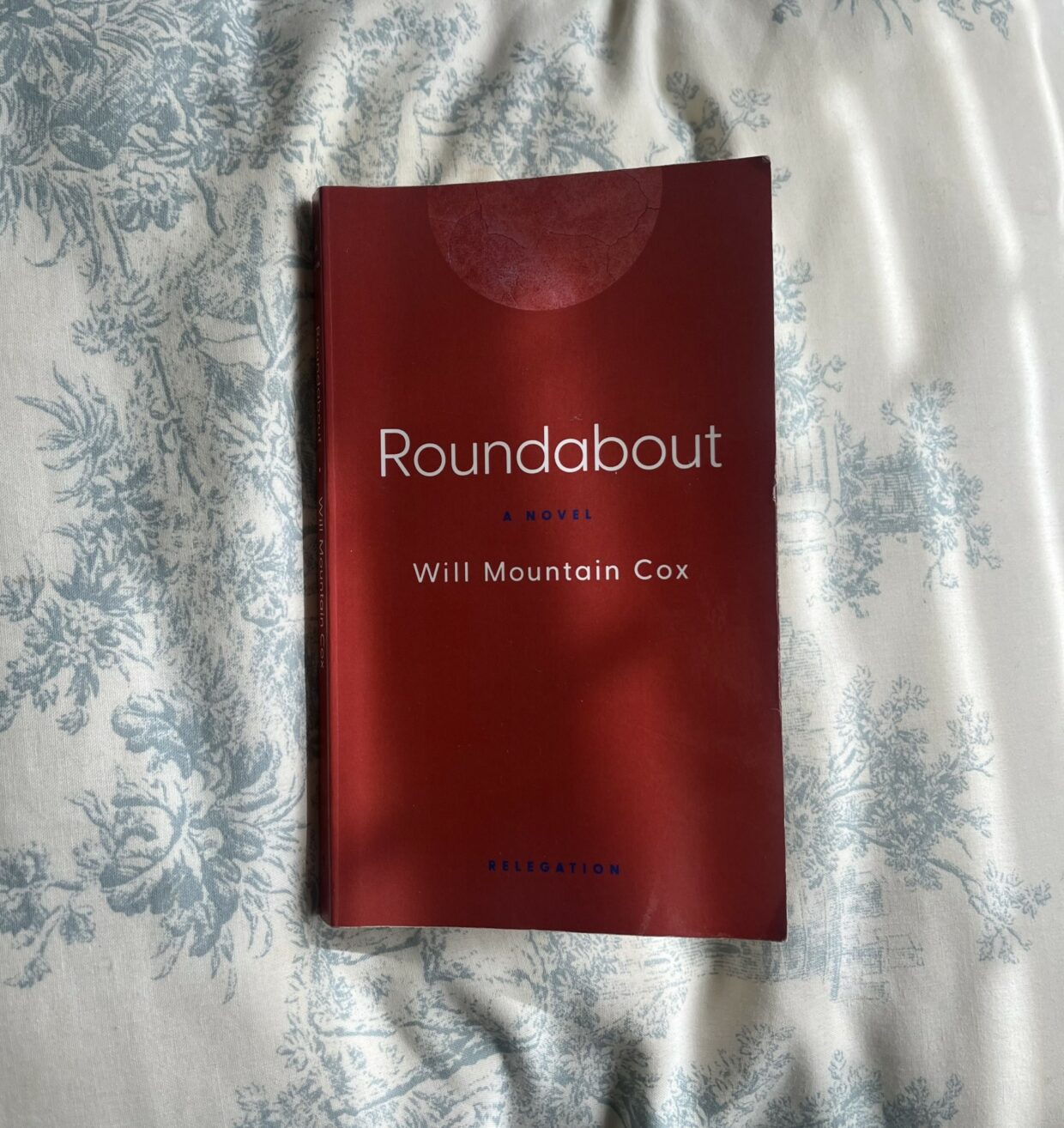Roundabout, Will Mountain Cox’s debut novel, places you in a Parisian bar. It unravels like a nature documentary, but if humans were the subject. Here you are, watching eight friends in their natural habitat while Cox narrates and establishes their habits, their sleeping patterns, how they welcome their young, how they fight for dominance, how they grow, lose, and love. An incredible example of character development, and setting as a character itself in a city that has so many times before been wrestled to the ground and demanded to be a stage, Cox’s novel flows with ease yet features intricacies that make every sentence meaningful.
The eight characters that Cox knows so well are Rachel, Matt, Jude, Lea, Marie, Eli, Pierre, and Sarah. They meet as regularly as they can in a bar on the brink of a roundabout, where six roads join. The friends echo the roundabout formation themselves, sitting in a circle and enjoying each other’s company. They find refuge in this place and one another. The symbolism of the roundabout is laced and carried throughout Cox’s novel, a motif so simple yet effective, as the eight friends not only represent different roads that each have their own destinations, but also the feeling that they are a cycle that cannot, and must not, be broken. It would have too devastating an effect on the already embedded and mapped formation. In roughly 170 pages, Cox places a new focus on each character, and you get the feeling he understands every second of their lives that has led them to this moment.
Two additional characters in Cox’s story are the bar itself, full of its own personality and status, and Paris, which hums eternally in the background. The bar is where life pauses but also where it reaches full momentum. The stories that Cox’s characters tell each other that have happened off-page or in the past are retold under the influence again of beers, shots, and the general adrenaline felt from being in a group setting with those you are closest to. Anyone who has experienced this will read Roundabout and smile. Listening to Eli recount his climactic (or anti-climactic, as Matt would say) story of a near-frightening experience he had on his travels made me feel like I was sitting at a table nearby, eavesdropping on a conversation that I wished to be a part of. The bar’s walls enclose these stories and keep them secret, yet you can visualise Karim, the briefly mentioned barman who exists only in this setting, polishing glasses and smiling in admiration as he observes both the group and us. The status of the bar as a character reads like an old fashioned television sitcom, in which a close-knit group of characters meet continuously in one place and become furniture themselves, though in Cox’s novel a laughing track is replaced by sirens, some commotion outside, and silences between characters that has you reflecting on your own relationships, allowing them privacy.
Cox is aware of Paris’ status, he does not try too hard to make it his own in his writing. He doesn’t need to. Rather, he understands and enjoys the collective nature of Paris, and what it symbolises to so many. He describes it gently:
‘And when the city was at its coldest, with a winter film of crystallized pollution hanging fuzzy over the capital as its fog,’ p.17
‘Outside the spotlights of the Eiffel wove round through the low-hanging clouds’ p.30
‘Always going on. Peugeots and Renaults and Citroens went turning through the roundabout outside, their headlights beaming through the bar windows, stage-lighting their faces at haunting, unflattering angles.’ p.19
My personal favourite, that truly encapsulates Cox’s attention to detail, describes Marie and Nathan, a new temporary lover of hers that she introduces to the roundabout, leaving her friends and the bar and encountering a woman singing on the streets:
“Standing in front of the artistic bar’s terrace was an Edith Piaf impersonator, half way through a rendition of “Non, je ne regrette rien.” She was being booed. Marie pulled Nathan away and they became yet another couple in the Parisian night. The crowd around the singer, however, grew more and more savage, but the singer persisted, stamping her feet to the rhythm. She was blonde, though the dirt matted in her hair made her near enough a brunette, and she stank, her smell seeming to mount alongside the song’s crescendo. (…) Some began to scream, mainly men, that she was degrading a French icon. Fewer women screamed, though they did move closer, insulting the singer’s looks and her state of decay. Surrounded, quiet, the impersonator smiled as she continued tapping the song’s rhythm with her foot, conducting the terrace’s anger.’ p.84
Cox is able to anthropomorphize Paris’ romanticisation and obsession with its past, and its ability to cause frustration when it is changed or interpreted wrong. Cox’s Paris is aware of its status. It especially knows what you, the reader, think and expect of it. Yet here it takes a step back, it lets its characters and their stories be heard, it lets Cox take the wheel. At the beginning of each chapter, he collectively describes scenes of riots, of the Notre Dame burning, of street muggings. Cox sensitively addresses contemporary scenes before he plunges us back into the temporary safety of the bar.
Cox’s novel is a great example of ensemble fiction, focusing on not one individual but a group, demonstrating how crucial our connections are, and how we all play a cog. As a different character takes center stage in each section, you understand various snippets of who they are, and why they are. It is so effective that when they are pushed into the background of another character’s chapter, you are still wondering what they are thinking and almost sure of how they will react to what is unfolding. Cox’s descriptions of camaraderie, playful insults, and banter between friends are poignant, surely taken and inspired by the author’s own experiences with those who have joined his life at various points. A beautiful chapter unfolds in Jude and Lea have a happy baby. We witness the group interacting with the baby, each in their own ways. Some are delighted and easygoing, others uncomfortable and clumsy, not knowing how to hold or entertain the newest, yet arguably, most permanent fixture to their roundabout structure. There is a crucial rawness in Cox’s writing. as well as warmth and often humour, in his characters’ dialogue and thoughts.
Roundabout is the perfect novel for writers to take inspiration from. It is presented as a pamphlet of thoughtful description, mirrored images, and realistic characters by an author who knows his craft. It is also a weekend in Paris for those with wanderlust, a book for those who wish to sit and eavesdrop on a group of friends in a bar where everything inside is intentional, apart from the words they speak after one too many. It is fleeting, fresh, and allows contrast to play the ultimate role; the constant moving of the roundabout, yet its stationary position on the map; lovers who leave, friends who become lovers; the secret journeys we take mentally and physically, and finally, how in this ever-changing world where old meets new and tradition meets change, the most important thing is those who stick by us: our friends.
Roundabout is available to buy in the UK on Amazon.
Anna Edwards

